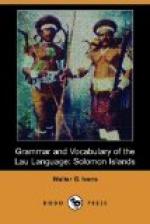ARTICLES.
(a) Demonstrative: Singular, na, si; ta, te, ke; maae; fe. Plural, gi; mwai, ote.
(b) Personal: a, ni.
Na denotes a, any, the, and is put to more general use than the corresponding nga in Sa’a; na is used with both singular and plural: na noni the body; na sasigamu your brethren. The conjunction ma (=and) coalesces with na; mana Mwela and the Son. Na is used with the interrogative taa what.
2. Si is more definite and particular in meaning than na and denotes a part, a piece, any; it is more or less equivalent to me’i in Sa’a: si doo ne the thing; gamelu ka ania si taa what are we to eat? si ere a firestick; si doo gu saea na that which I said; na may be prefixed: na si baea taa ne what words? si can not be used of the plural.
3. Ta means a certain one, every, at all, just, only, and is the same as the numeral ta one: ta may precede the article fe; ta fe uo every hill, ni may follow ta: tani aiai some, other. ta may mean only: ta ro ai only two people; ta may be used with the numerals, ta ro mwane two men; ta ro tangale penny 200 pence.
Te has practically the same meanings as ta: te geni sarii a maiden; te taifilia he alone; te aiai falaete one person only. Te is used of units (as ata in Sa’a), te fiu fe doo only seven things; te ai ma te ai one by one; too te ai singly. Si may follow both ta and te: ta si fou a certain rock, te si na doo everything; te may be used as equivalent to the conjunction and: te na Mwela and the Son.
Ke is used as te: ke si gula iidimani a small piece; ro kesi kurui bata two small pieces of money. Ke and si may be combined and used with te: e langi asia na teke si doo there is nothing at all.
4. Maae is compounded of maa eye, one, and e the construct form, and means one, a; maae is used with fera country, dangi day, rodo night, oru wind; maae fera a village, maaedangi a day, maaerodo darkness.
5. Qe is used with certain nouns: qe afe a widow, qe ia a fish, qe oru a widow; na may be prefixed: na qe ia gi the fishes.
6. Fe is used of things spherical in shape and denotes a unit: fe bread a loaf, fe bubulu a star; also fe gale bola a young pigeon, fe rade a reed; fe is used of one of a series: fe rodo a night, fe asua a day; fe is also used as a multiplicative: fe fiu ade doo taala seven cases of wrong-doing; na or ta or te may precede.




